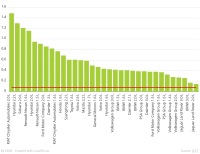
Photo from wikipedia
Diesel-powered road vehicles are important sources for nitrogen oxide (NOx) emissions, and the European passenger fleet is highly dieselised, which has resulted in many European roadside environments being noncompliant with… Click to show full abstract
Diesel-powered road vehicles are important sources for nitrogen oxide (NOx) emissions, and the European passenger fleet is highly dieselised, which has resulted in many European roadside environments being noncompliant with legal air quality standards for nitrogen dioxide (NO2). On the basis of vehicle emission remote sensing data for 300000 light-duty vehicles across the United Kingdom, light-duty diesel NOx emissions were found to be highly dependent on ambient temperature with low temperatures resulting in higher NOx emissions, i.e., a “low temperature NOx emission penalty” was identified. This feature was not observed for gasoline-powered vehicles. Older Euro 3 to 5 diesel vehicles emitted NOx similarly, but vehicles compliant with the latest Euro 6 emission standard emitted less NOx than older vehicles and demonstrated less of an ambient temperature dependence. This ambient temperature dependence is overlooked in current emission inventories but is of importance from an air quality perspective. Owing to Europe’s climate, a predicted average of 38% more NOx emissions have burdened Europe when compared to temperatures encountered in laboratory test cycles. However, owing to the progressive elimination of vehicles demonstrating the most severe low temperature NOx penalty, light-duty diesel NOx emissions are likely to decrease more rapidly throughout Europe than currently thought.
Journal Title: Environmental Science & Technology
Year Published: 2019
Link to full text (if available)
Share on Social Media: Sign Up to like & get
recommendations!